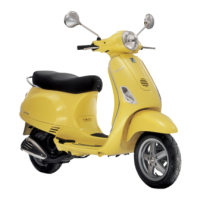
Do you have a question about the Vespa LX 125 150 Euro 3 and is the answer not in the manual?
| Transmission | Automatic CVT |
|---|---|
| Engine Type | 4-stroke single cylinder |
| Displacement | 124 cc / 150 cc |
| Torque | 9.6 Nm at 6, 250 rpm (LX 125), 11.5 Nm at 6, 500 rpm (LX 150) |
| Front Suspension | Single arm with coil spring and hydraulic shock absorber |
| Front Brake | 200 mm disc |
| Weight | 114 kg |
| Length | 1, 770 mm |
| Wheelbase | 1, 280 mm |
| Cooling System | Air |
Overview of the vehicle's dashboard, including speedometer, odometer, and fuel gauge.
Details on the digital clock display, its functions, and battery replacement.
Operation of the key switch, including locking and releasing the steering wheel.
How to operate the turn indicators.
How to operate the horn button.
Operation of the light switch.
Procedure for starting the engine using the starter button.
Introduction to the anti-theft system, keys, and code card.
Function and behavior of the immobilizer system's indicator LED.
Step-by-step guide for programming immobilizer keys.
Procedure for opening the saddle using the key.
Location and importance of chassis and engine identification numbers.
How to open the rear top box using the key.
Instructions for using the retractable bag hook located on the saddle.
Essential checks before using the vehicle.
Guidelines for safely refueling the fuel tank with unleaded petrol.
Recommended tyre pressures for safe operation.
How to adjust the shock absorber preload for different load conditions.
Recommendations for the initial running-in period.
Procedure for starting the engine.
Troubleshooting steps for common engine starting problems.
Correct procedure for switching off the engine.
Tips and precautions for safe operation of the scooter.
Checking, topping up, and changing engine oil.
Meaning and action required for the oil pressure warning light.
How to check and maintain the oil level in the rear hub.
Checking tyre wear indicators and pressure for safe riding.
Procedure for removing and inspecting the spark plug.
Steps for removing and cleaning the air filter.
Description of the secondary air system for emission control.
Checking the brake fluid level and recommended fluid type.
Accessing and maintaining the scooter's battery.
Checking battery electrolyte and storing for inactivity.
Locating and checking/replacing fuses for the electrical system.
Details on bulb types and procedures for replacing them.
Accessing headlight bulbs and adjusting beam alignment.
Procedures for replacing front and rear indicator bulbs.
Procedure for accessing and replacing the number plate light bulb.
Adjusting and removing the rear-view mirrors.
Procedure for adjusting the engine's idle speed.
Information on front disc brake pad wear and system checks.
Procedure for adjusting the rear drum brake.
Guidance on repairing tubeless tyre punctures.
Preparing the scooter for storage and cleaning procedures.
Diagnosing and resolving issues with spark plug and ignition.
Troubleshooting low compression and high fuel consumption.
Diagnosing and resolving problems with brakes, suspension, and transmission.
Troubleshooting exhaust noise and stand return problems.
Detailed technical specifications for the 125cc model.
Key technical specifications for the 150cc model.
List of tools included in the vehicle's kit.
Recommendations on using original parts and authorized accessories.
Overview of maintenance tasks at specified intervals.
